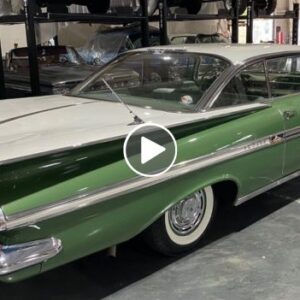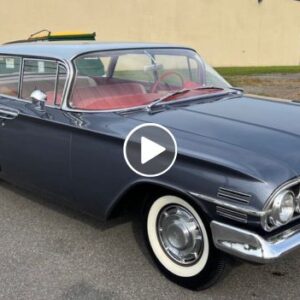The Chevrolet Corvette Stingray 1963 is an iconic American sports car that has become a symbol of performance and style. Here are some key details and information about this classic vehicle
1.Introduction
The 1963 Chevrolet Corvette Stingray was the second generation of the Corvette line, known as the C2 generation. It featured a sleek, aerodynamic design with a distinctive split rear window, which is one of its most recognizable features.
2.Design
The Stingray’s design was heavily influenced by the Corvette Stingray Racer concept car, designed by Larry Shinoda and Bill Mitchell. It had a sharp, aggressive look with hidden headlights, a long hood, and muscular rear fenders.
Split-Window Design
One of the most distinctive and defining features of the 1963 Corvette Stingray is its split rear window. This unique design element, although controversial at the time, became an instant icon. The split window was intended to improve rear visibility, but it was later discontinued due to visibility concerns, making the 1963 model year particularly special.
Sleek and Aerodynamic Shape
The Stingray had a sleek and aerodynamic shape that was ahead of its time. It featured a long, sloping hood, flowing body lines, and muscular rear fenders. The overall design exuded a sense of speed and elegance, making it visually striking.
Hidden Headlights
The 1963 Corvette Stingray was one of the first production cars to feature hidden headlights. When not in use, the headlights were concealed beneath a sleek cover, giving the front end a clean and uninterrupted appearance.
Emphasis on Functionality
The Stingray’s design was not solely focused on aesthetics; it also prioritized functionality. The car had a lightweight fiberglass body, which helped reduce weight and improve performance. The incorporation of aerodynamic elements, such as the functional hood vents and side coves, helped enhance airflow and cooling.
Interior Refinements
The interior of the 1963 Stingray was redesigned to provide improved comfort and usability. It featured a driver-centric cockpit layout, with a centered instrument cluster and a deep-dish steering wheel. The overall design aimed to enhance the driving experience and provide better ergonomics.
3.Powertrain
The 1963 Stingray came with several engine options, ranging from a 327 cubic inch V8 engine producing 250 horsepower to a fuel-injected 327 cubic inch V8 engine that generated 360 horsepower. The most powerful engine available was the “fuelie” (fuel-injected) 327 V8, providing impressive performance for its time.
Engine Options
The 1963 Stingray came with various engine choices, allowing buyers to select the level of performance that suited their preferences. The engine options included:
a. Base V8 Engine
The base engine was a 327 cubic inch (5.4-liter) V8 that produced 250 horsepower. This engine featured a two-barrel carburetor and was the standard option for the Stingray.
b. Fuel-Injected V8 Engines
The Stingray also offered high-performance fuel-injected V8 engines. The most powerful option was the 327 cubic inch (5.4-liter) fuel-injected V8, producing 360 horsepower. There were also intermediate options with 300 and 340 horsepower.
c. Optional V8 Engines
Additionally, there were optional V8 engines available, such as the 327 cubic inch (5.4-liter) V8 with a four-barrel carburetor, producing 300 or 340 horsepower.
Performance and Speed
With its powerful engines and lightweight construction, the 1963 Stingray delivered impressive performance for its time. The specific performance numbers varied depending on the engine choice and configuration, but the Stingray could achieve 0-60 mph (0-97 km/h) times in the range of 5.5 to 7 seconds. Top speeds varied between 120 and 150 mph (193-241 km/h), depending on the engine and gearing.
4.Performance
The Stingray was known for its exceptional performance, offering quick acceleration and impressive handling capabilities. The lightweight construction and powerful engines allowed it to achieve impressive speed and agility.
Acceleration
The Stingray offered quick acceleration, thanks to its powerful engine options and lightweight construction. Depending on the engine choice, the Stingray could achieve 0-60 mph (0-97 km/h) times in the range of 5.5 to 7 seconds.
Top Speed
The top speed of the 1963 Corvette Stingray varied depending on the engine and gearing options. The car could achieve top speeds ranging from approximately 120 to 150 mph (193-241 km/h), depending on the specific configuration.
Handling and Suspension
The Stingray introduced an independent rear suspension, which greatly improved its handling capabilities compared to its predecessor. This suspension setup provided better stability, traction, and cornering performance, making the Stingray more agile and responsive on the road.
Braking
The braking performance of the 1963 Stingray was enhanced with the use of power-assisted brakes. The power-assisted braking system provided improved stopping power and control, allowing drivers to confidently bring the car to a halt.
5.Notable Features
In addition to its distinctive design, the 1963 Corvette Stingray introduced some notable features such as independent rear suspension, which improved the car’s ride and handling, and a redesigned interior with improved comfort and ergonomics.
6.Racing Success
The Corvette Stingray was also successful in motorsports, particularly in endurance racing. It competed in events like the 24 Hours of Le Mans and achieved notable victories, further solidifying its reputation as a performance car.
7.Rarity and Value
The 1963 Corvette Stingray is highly sought after by collectors due to its classic design, performance, and historical significance. Well-preserved examples of the split-window Stingray are particularly rare and valuable in today’s market.
Split-Window Rarity
The split-window design was only featured in the 1963 model year, and it was later discontinued due to visibility concerns. This makes the 1963 Corvette Stingray with the split rear window particularly rare and desirable among collectors. The split-window feature has become an iconic and distinguishing characteristic of the 1963 model.
Limited Production
While the exact number of split-window Stingrays produced in 1963 is not known, it is estimated that Chevrolet produced around 10,594 Corvettes that year. However, it’s important to note that not all of them had the split-window design, as it was an optional feature. The split-window models are believed to be a smaller portion of the overall production.
Collector’s Value
The rarity and iconic status of the 1963 Corvette Stingray with the split rear window significantly contribute to its collector’s value. Well-preserved examples of the split-window Stingray are highly sought after, and their value can vary depending on factors such as condition, originality, provenance, and desirability.
Overall, the 1963 Chevrolet Corvette Stingray is a legendary car that has left a lasting impact on the automotive industry. Its timeless design and powerful performance have made it an enduring symbol of American muscle cars.





